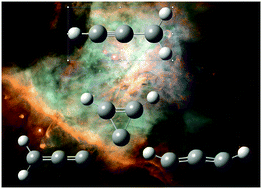当前位置:
X-MOL 学术
›
Phys. Chem. Chem. Phys.
›
论文详情
Our official English website, www.x-mol.net, welcomes your
feedback! (Note: you will need to create a separate account there.)
Isomer-specific detection in the UV photodissociation of the propargyl radical by chirped-pulse mm-wave spectroscopy in a pulsed quasi-uniform flow
Physical Chemistry Chemical Physics ( IF 2.9 ) Pub Date : 2017-11-13 00:00:00 , DOI: 10.1039/c7cp06211g Bernadette M. Broderick 1, 2, 3 , Nicolas Suas-David 1, 2, 3 , Nureshan Dias 1, 2, 3 , Arthur G. Suits 1, 2, 3
Physical Chemistry Chemical Physics ( IF 2.9 ) Pub Date : 2017-11-13 00:00:00 , DOI: 10.1039/c7cp06211g Bernadette M. Broderick 1, 2, 3 , Nicolas Suas-David 1, 2, 3 , Nureshan Dias 1, 2, 3 , Arthur G. Suits 1, 2, 3
Affiliation

|
Isomer-specific detection and product branching fractions in the UV photodissociation of the propargyl radical is achieved through the use of chirped-pulse Fourier-transform mm-wave spectroscopy in a pulsed quasi-uniform flow (CPUF). Propargyl radicals are produced in the 193 nm photodissociation of 1,2-butadiene. Absorption of a second photon leads to H atom elimination giving three possible C3H2 isomers: singlets cyclopropenylidene (c-C3H2) and propadienylidene (l-C3H2), and triplet propargylene (3HCCCH). The singlet products and their appearance kinetics in the flow are directly determined by rotational spectroscopy, but due to the negligible dipole moment of propargylene, it is not directly monitored. However, we exploit the time-dependent kinetics of H-atom catalyzed isomerization to infer the branching to propargylene as well. We obtain the overall branching among H loss channels to be 2.9% (+1.1/−0.5) l-C3H2 + H, 16.8% (+3.2/−1.3) c-C3H2 + H, and 80.2 (+1.8/−4.2) 3HCCCH + H. Our findings are qualitatively consistent with earlier RRKM calculations in that the major channel in the photodissociation of the propargyl radical at 193 nm is to 3HCCCH + H; however, a greater contribution to the energetically most favorable isomer, c-C3H2 + H is observed in this work. We do not detect the predicted HCCC + H2 channel, but place an upper bound on its yield of 1%.
中文翻译:

脉冲准均匀流中chi脉冲毫米波光谱法检测炔丙基自由基的紫外光解离中的异构体特异性检测
炔丙基自由基在紫外光解离中的异构体特异性检测和产物支化级分是通过在脉冲准均匀流(CPUF)中使用chi脉冲傅里叶变换毫米波光谱仪实现的。丙炔基自由基是在1,2-丁二烯的193 nm光解离中产生的。吸收第二个光子会导致H原子消除,从而提供三种可能的C 3 H 2异构体:单线态环丙烯基(c -C 3 H 2)和丙二烯基(l -C 3 H 2),以及三重态丙烯基(3HCCCH)。单线态产物及其在流动中的外观动力学可通过旋转光谱法直接确定,但由于丙炔的偶极矩可忽略不计,因此无法对其进行直接监测。但是,我们利用H原子催化的异构化反应的时变动力学来推断支化为炔丙基。我们获得的H损耗通道之间的总分支为2.9%(+ 1.1 / -0.5)l -C 3 H 2 + H,16.8%(+ 3.2 / -1.3)c -C 3 H 2 + H和80.2( + 1.8 / −4.2)3 HCCCH +H。我们的发现与早期RRKM计算在质量上是一致的,因为炔丙基在193 nm处的光离解的主要通道是3 HCCCH + H;然而,在这项工作中观察到了对能量最有利的异构体c -C 3 H 2 + H的更大贡献。我们没有检测到预测的HCCC + H 2通道,但是将其1%的产率设为上限。
更新日期:2017-11-22
中文翻译:

脉冲准均匀流中chi脉冲毫米波光谱法检测炔丙基自由基的紫外光解离中的异构体特异性检测
炔丙基自由基在紫外光解离中的异构体特异性检测和产物支化级分是通过在脉冲准均匀流(CPUF)中使用chi脉冲傅里叶变换毫米波光谱仪实现的。丙炔基自由基是在1,2-丁二烯的193 nm光解离中产生的。吸收第二个光子会导致H原子消除,从而提供三种可能的C 3 H 2异构体:单线态环丙烯基(c -C 3 H 2)和丙二烯基(l -C 3 H 2),以及三重态丙烯基(3HCCCH)。单线态产物及其在流动中的外观动力学可通过旋转光谱法直接确定,但由于丙炔的偶极矩可忽略不计,因此无法对其进行直接监测。但是,我们利用H原子催化的异构化反应的时变动力学来推断支化为炔丙基。我们获得的H损耗通道之间的总分支为2.9%(+ 1.1 / -0.5)l -C 3 H 2 + H,16.8%(+ 3.2 / -1.3)c -C 3 H 2 + H和80.2( + 1.8 / −4.2)3 HCCCH +H。我们的发现与早期RRKM计算在质量上是一致的,因为炔丙基在193 nm处的光离解的主要通道是3 HCCCH + H;然而,在这项工作中观察到了对能量最有利的异构体c -C 3 H 2 + H的更大贡献。我们没有检测到预测的HCCC + H 2通道,但是将其1%的产率设为上限。











































 京公网安备 11010802027423号
京公网安备 11010802027423号